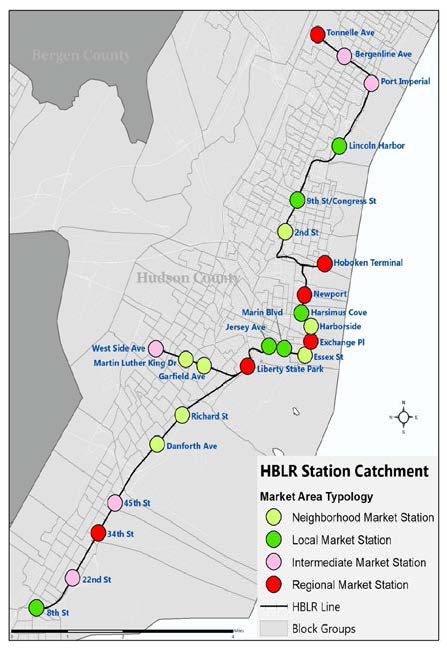NJDOT Research
 The objective of this research study was to conduct a comprehensive onboard survey of Hudson Bergen Light Rail (HBLR) weekday riders and use the results of the survey and analysis of secondary data to identify the ridership catchment area of the HBLR system, in the context of its interaction with other transportation modes in the area. Analysis of 3,300 completed surveys found that the vast majority of HBLR riders are frequent users and more than 80 percent of all trips made on the HBLR are for work commute purposes. Most riders live nearby and walk to their boarding station, but a substantial number of riders also drive to stations, use NJ TRANSIT trains, PATH trains, and buses to access stations. Most riders using the HBLR travel to destinations within Hudson County. For HBLR riders who travel to New York, PATH is the predominant egress mode. Approximately two in five HBLR riders frequent area businesses within 1/2-mile of their boarding station. In total, HBLR riders report spending $3.4 million per month and more than $41 million annually in station areas.
The objective of this research study was to conduct a comprehensive onboard survey of Hudson Bergen Light Rail (HBLR) weekday riders and use the results of the survey and analysis of secondary data to identify the ridership catchment area of the HBLR system, in the context of its interaction with other transportation modes in the area. Analysis of 3,300 completed surveys found that the vast majority of HBLR riders are frequent users and more than 80 percent of all trips made on the HBLR are for work commute purposes. Most riders live nearby and walk to their boarding station, but a substantial number of riders also drive to stations, use NJ TRANSIT trains, PATH trains, and buses to access stations. Most riders using the HBLR travel to destinations within Hudson County. For HBLR riders who travel to New York, PATH is the predominant egress mode. Approximately two in five HBLR riders frequent area businesses within 1/2-mile of their boarding station. In total, HBLR riders report spending $3.4 million per month and more than $41 million annually in station areas.
Evidence from this study suggests that the HBLR plays a dual role in northern New Jersey transportation landscape. Similar to many light rail systems throughout the world, the HBLR serves an important function as a collector/distributer system. In the case of the HBLR, the system facilitates intra-county travel in Hudson County along the waterfront. At the same time the HBLR also connects travelers to the larger regional transportation system facilitating inter-county travel via a variety of multimodal connections. Based on the results of this study, it can be concluded that the HBLR system and many of its stations have both a micro- and a macro-catchment area. The communities served directly by stations and, in particular, the immediate areas around stations make up the system’s micro-catchment area which includes a neighborhood market that is within a 1/2-mile linear buffer of stations and a local market area that extends to a 1-mile linear buffer of stations. The micro-catchment area is defined primarily by walking distance. The HBLR macro-catchment area includes both an intermediate market (a 1-5 linear mile buffer) and a regional market (>5-mile buffer). The macro-catchment area is defined by the various transportation modes that connect with the system at key stations. The intermediate market is connected to the HBLR primarily via bus and auto modes, while the regional market is connected via auto, bus, NJ TRANSIT trains and PATH trains.
Posted in Uncategorized.
